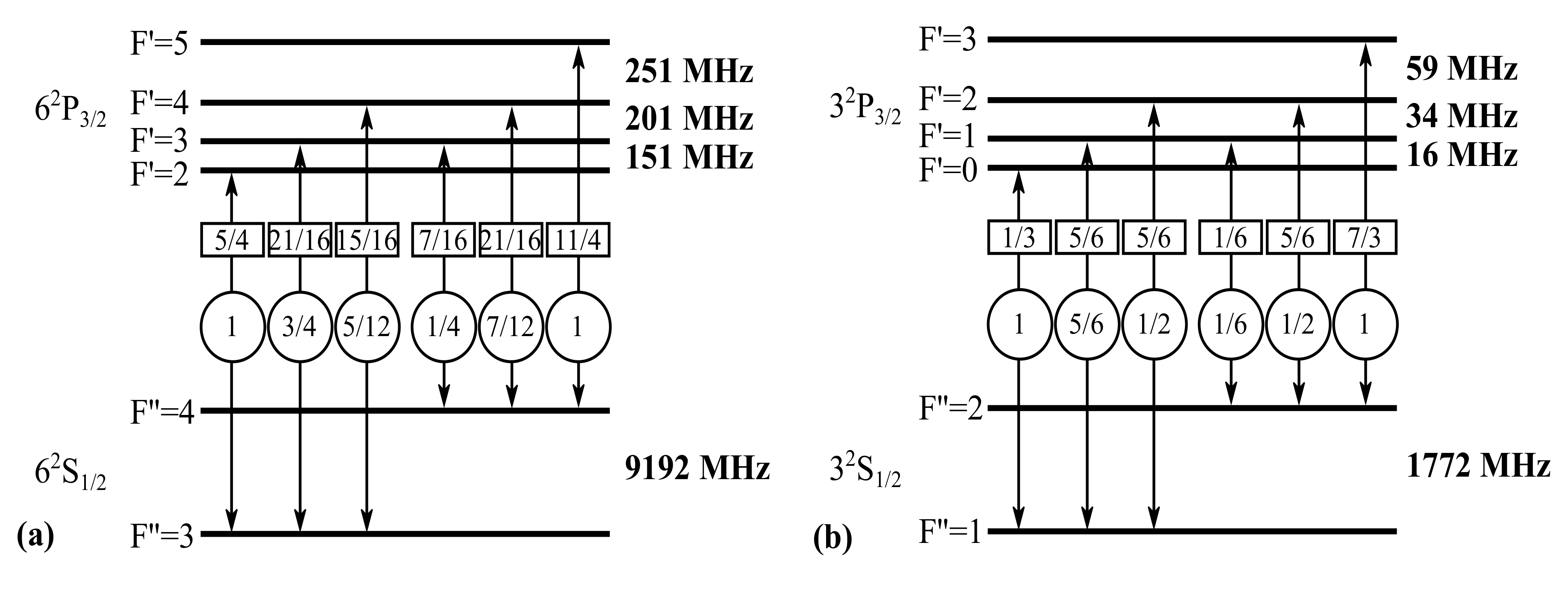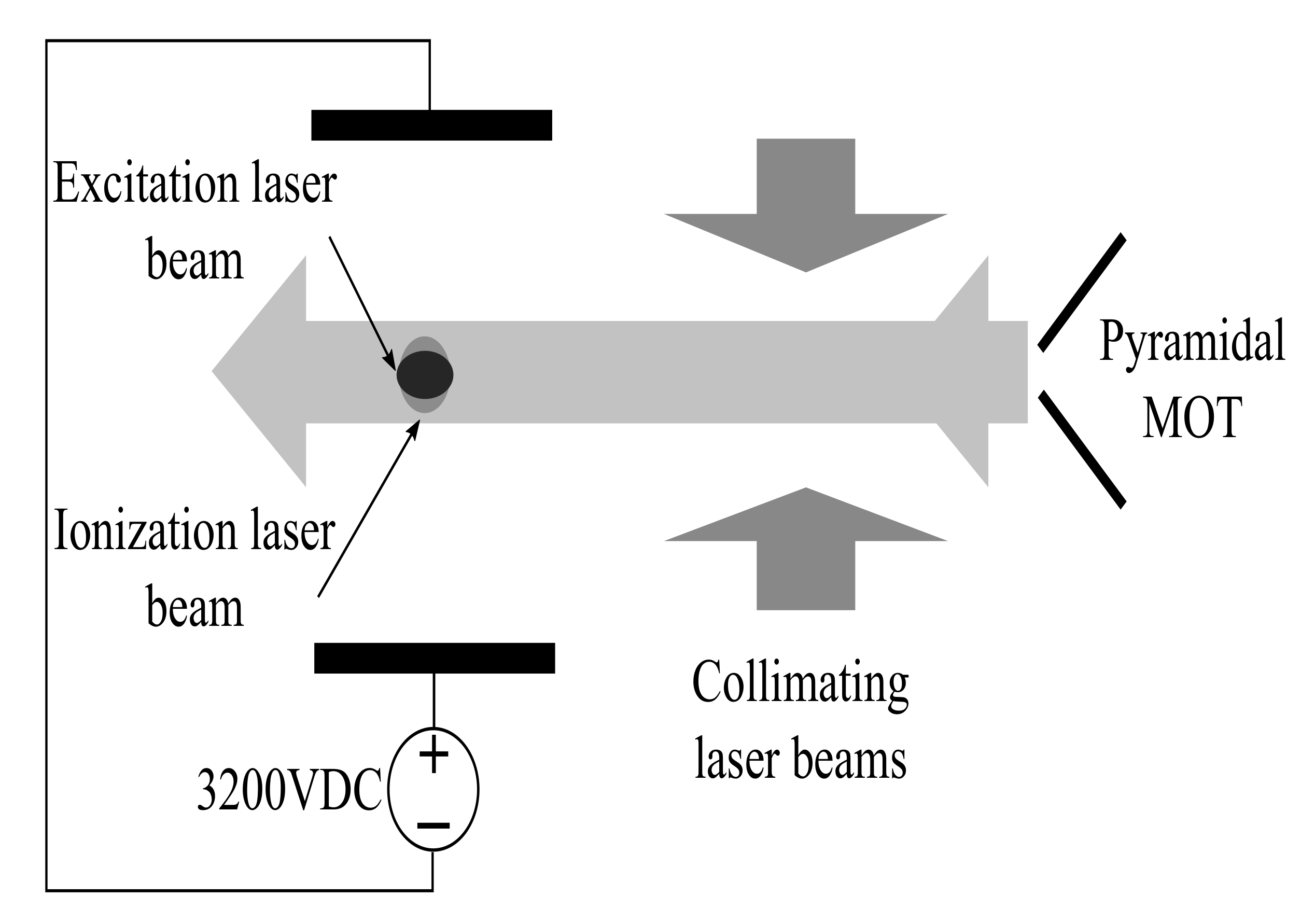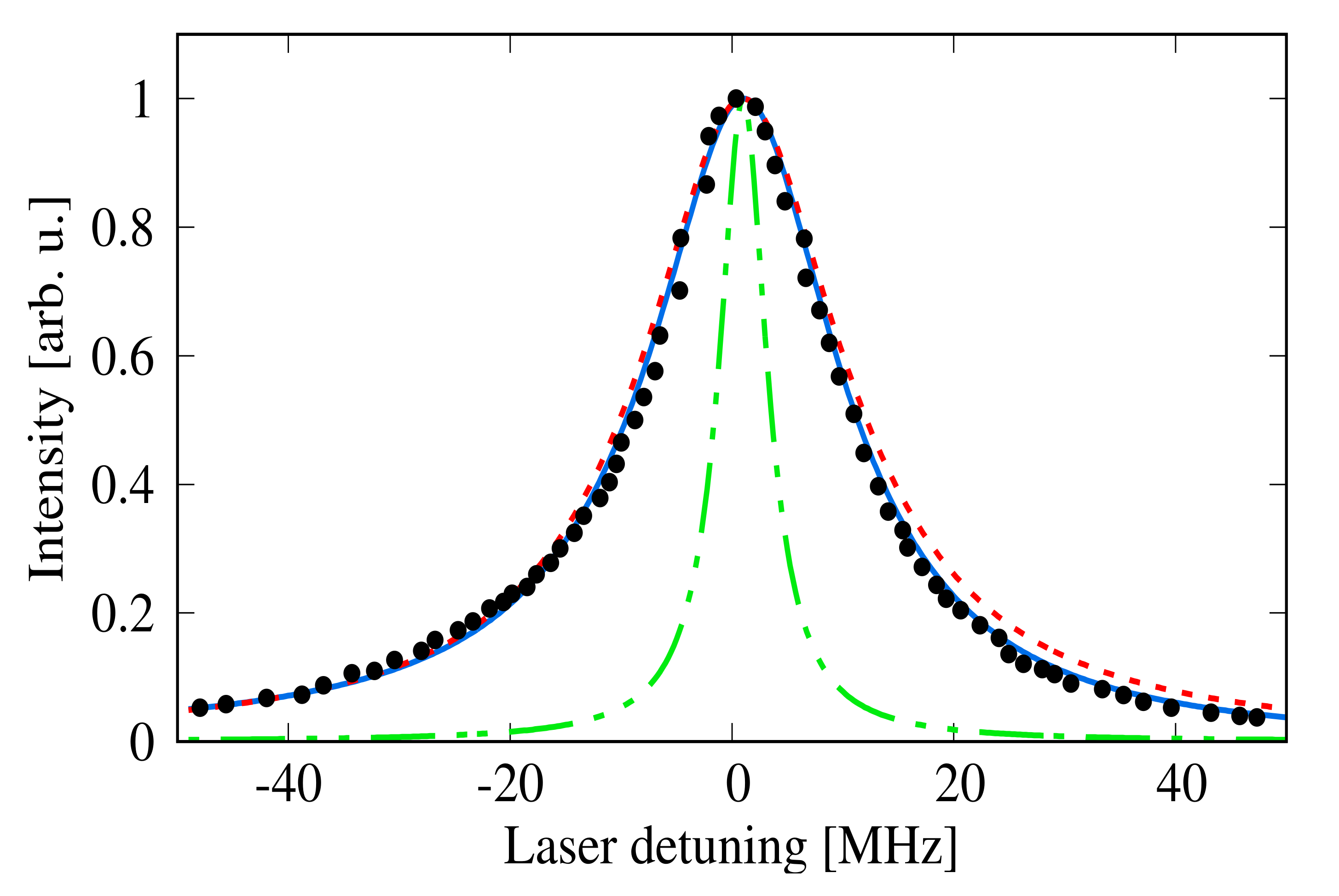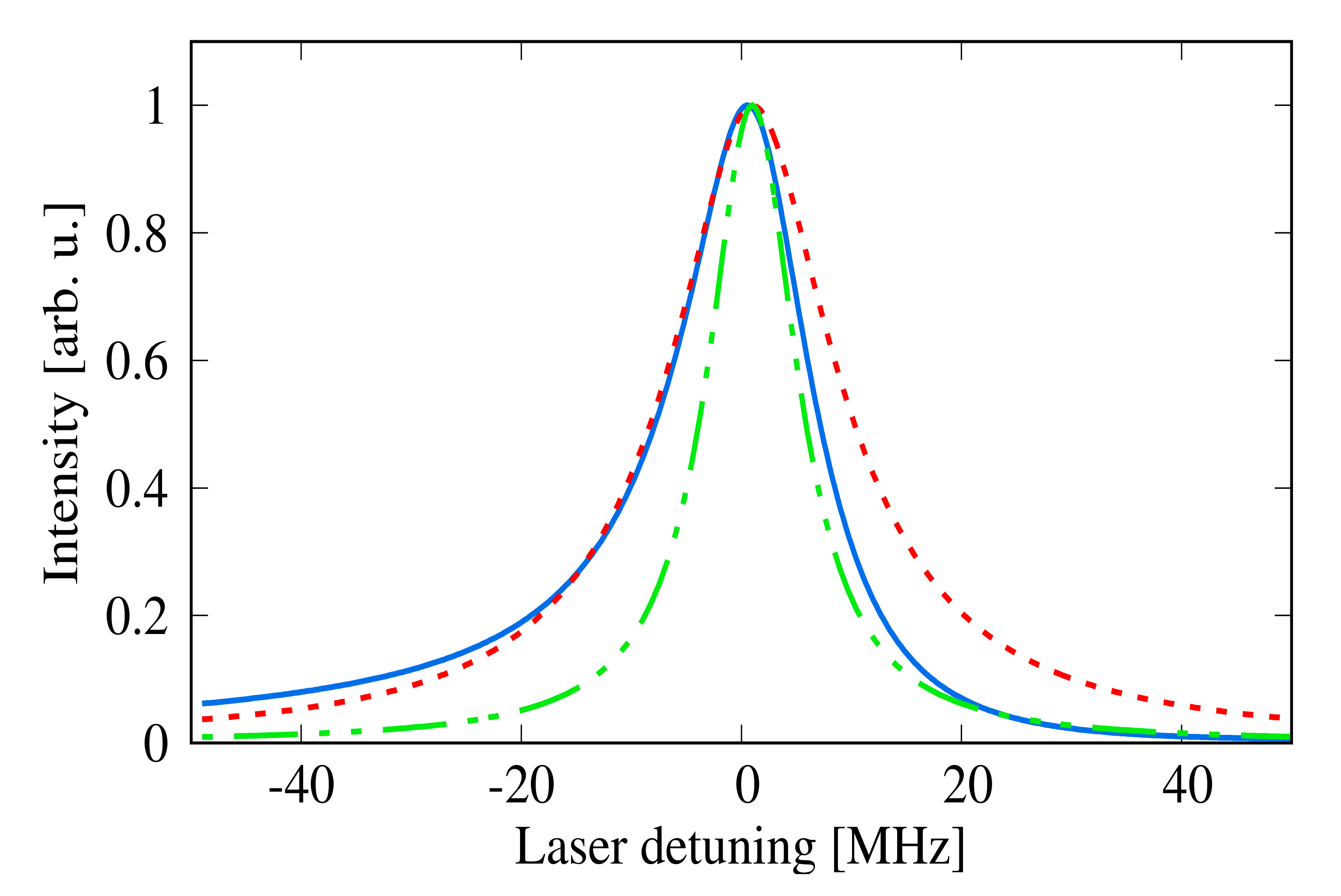1. Introduction
Investigation of the fluorescence spectrum of sodium atoms is an important data source for astrophysics and, especially, for understanding the physical processes in cool stars, namely, for brown and white dwarfs. For example, the measured precise atmospheric parameters for shortest period binary white dwarfs confirm the existence of metal-rich envelopes around extremely low-mass white dwarfs and allow us to examine the distribution of the abundance of non-hydrogen elements, including Na, as a function of effective temperature and mass [
1]. It is worth emphasizing that we can expect the gravitational wave strain for such systems.
Other interesting astrophysical objects are metal polluted white dwarfs and dusty white dwarfs. It has long been suspected that metal polluted white dwarfs (types DAZ, DBZ and DZ) and white dwarfs with dusty disks can possess planetary systems [
2]. Therefore, the spectroscopic observations of sodium atoms in these objects can confirm the validity of this hypothesis. It is in fact known that all dusty white dwarfs show evidence for alkali atoms accretion onto their dusty disk.
In reference [
3], the observational constraints on the origin of metals and alkali atoms in cool white dwarfs are discussed. The presence of absorption lines of Na, Mg, Fe etc in the photospheres of cool hydrogen atmosphere DA-type white dwarfs has been an unexplained problem for a long time. However, in [
4], it was shown that the metal abundances in the atmospheres of white dwarfs can be explained by episodic accretion events whenever the white dwarf travels through relatively overdense clouds.
Furthermore, Na 8183.27, 8192.81 Å absorption doublet was discovered in astrophysical systems of white dwarf–main sequence binaries. It allows us to investigate in detail the process of mass transfer interaction in these complex astrophysical systems.
In astrophysics, there is a wide interest in the search for dusty white dwarfs with powerful infrared excess. This excess is produced by orbiting dust disk that contains planetary systems and planetesimals. All these materials get accreted onto the white dwarf and enrich its pure hydrogen or/and helium atmosphere. Studying these heavy elements enriched white dwarfs becomes an effective way to measure directly the bulk compositions of extrasolar planetesimals [
5]. Na atoms can be the essential part of these heavy-element clouds; therefore, detailed knowledge of Na emission features can be extremely relevant for investigating such astrophysical problems.
Recently, combined Spitzer and ground-based Korea Microlensing Telescope Network observations identified and precisely measured an Earth-mass planet orbiting ultra cool dwarf [
6]. Observations of Na atoms in ultra cool dwarfs can become the effective method for determining planetesimals and Earth-mass planets in dusty disks surrounding the central ultra cool dwarf.
We note as well that, already in 1974, Brown [
7] detected the first neutral sodium cloud near Jovian satellite Io (see also [
8]). The investigation of these sodium clouds is needed for better understanding of the interaction between Io’s atmosphere and Jovian magnetosphere [
9] and of processes in the Jovian environment [
10].
We are concerned here with important particularities of cold alkali atoms absorption spectra in D2-lines (see
Figure 1) that result from a long interaction time of light and matter and, as a consequence, from a strong involvement of optical pumping phenomena within hyperfine (HF) components of the ground and excited states. The described novel theoretical predictions are compared with experimental data obtained in sub-thermal (cold) atomic beams [
11,
12] operated with two different alkali species, namely Na and Cs. Atomic units are used unless stated otherwise.
2. Formation of HF Absorption Multiplet for Partially Open Transitions
Absorption spectra of alkali atoms have a multiplet form due to HF structure of atomic states (see
Figure 1). There are two different classes of multiplet components corresponding to cyclic (or closed) and partially open (or non-cyclic) transitions between HF sublevels
and
of the resonant excited (e) and the ground (g) states, respectively. In the partially open case, each spontaneously emitted photon induces two transitions
in Na and
in Cs with probabilities
(see
Figure 1). The dimensionless parameter
is called the branching ratio. The cyclic transitions correspond to
and they are particularly important in cooling and trapping techniques of neutral atoms, for example, in magneto-optical traps (MOTs) [
13].
Excitation of the partially open individual transition
is accompanied by optical pumping phenomenon that is usually associated with redistribution of population within HF sublevels of the ground state because of interaction with resonant light fields [
14]. Line-shape effects due to optical pumping (the so-called depletion broadening) in the weak excitation limit and long interaction time
were examined in detail in [
15]. A convenient approximation in describing the time-dependent population dynamics of HF sublevels
is a two-level model. Atoms are excited on the atomic transition by monochromatic laser radiation with frequency
, amplitude
, and detuning
. If the laser intensity is insufficient to saturate the transition, which corresponds to Rabi frequency
(
, where
is the atomic dipole operator) being below the natural linewidth
of the excited state, then the rate of spontaneous transitions per one atom is equal to [
14]:
In a partially open system, each spontaneously emitted photon returns to g-state the
-portion of the population, while the remaining
-portion is transferred to states outside the two-level system. It means the depletion rate
is equal to
and the lower state population
of the atom decays exponentially
at the time
upon transit through the laser beam. The corresponding pumping time is
, i.e.,
In experiments involving atom beams crossed by the laser radiation [
11,
12], we can identify a transit time
. In such conditions, the total population after the atom beam has crossed the laser radiation,
, becomes
. Thus, the criterion for the development of optical pumping is
, or in terms of Rabi frequencies
where
is the radiative lifetime of the upper e-state. The ratio
for cold atomic beams acquires values of ∼10
(
ns,
s) [
3]. Therefore, the depletion manifestation can be observed at Rabi frequencies well below (by two orders of magnitude) the saturation frequency
; exceeding this value results in the development of nonlinear (power broadening) and quantum optics effects [
14].
Important spectroscopic features of optical pumping emerge when the Rabi frequency is set close, or above, the critical value
(
3) [
15]. Conventional experiments would usually register the fluorescence signal
J (absorption line) from the entire excitation volume, which is proportional to the total number
of photons emitted by a single atom. On the other hand, the number
of spontaneously emitted photons on transitions outside the
g-
esystem is equal to the total loss
of the ground state population, so that the signal
J can be written as
Equation (
4) yields a dependence of the fluorescence signal on the laser detuning
in the following explicit form:
The above equation and data presented in
Figure 2 show that the absorption spectrum strongly depends on the pumping parameter
defined as in Equation (
6), which is given by the ratio of transit time
and pumping time
. The latter has the meaning of optical pumping time at resonant excitation, when
. Importantly, the parameter
can be large even at laser intensities well below the saturation limit:
when
and
.
According to Equation (
4), optical pumping leads to saturation of the fluorescence signal at the value of
. This fact along with redistribution of intensities within
D2-line multiplet have been predicted and experimentally demonstrated in [
15]. Another phenomenon described by Equations (
4) and (
5) is related to depletion broadening of the absorption line. As an estimation of the characteristic full width
of the spectral absorption profile induced by optical pumping, one can write
In the case of cold beams of alkali atoms, with
and
for
(see Equation (
3)), the width
acquires the form
, which may essentially exceed the power broadening effects (
) even in the limit of weak excitation. The corresponding experimental investigation of spectral broadening due to optical pumping (the parameter
) in partially open HF level systems in Na has been reported in [
15]. We note that, since the experiments were performed at low number densities (∼10
) of Na atoms, line-shape modifications by radiation trapping in collimated beams [
16] can be disregarded.
3. Experimental Setup and Spectroscopic Data
Common experimental practice foresees the use of two types of thermal beams: effusive beam with longitudinal velocity
m/s [
17], and crossed beams with
m/s [
18]. The second type represents a supersonic beam with
m/s [
15] and a rather specific velocity distribution function [
19]. An additional experimental possibility is represented by laser cooled atomic beams [
20,
21], which are characterized by small
around 12 m/s, which corresponds to the sub-thermal temperature interval lying below 1 K and practically negligible transversal velocity.
At the core of the relevant setup is a hollow pyramid with reflective inner surfaces and a hole at its vertex. By shining a single, large diameter (35 mm) laser beam along the pyramid axis, the optical configuration of an MOT is achieved. Imbalance of the radiation pressure along the pyramid axis pushes Cs atoms out of the pyramid hole. Further collimation of the atoms is achieved by a transverse optical molasses right after the pyramid hole (
Figure 3). The atom beam is then excited by a diode laser tunable over the hyperfine transitions belonging to the
D2-line of Cs; blue laser radiation is superposed in order to ionize the excited atoms. The production rate of ions is proportional to the total number of excited atoms in the excitation volume. Ions are effectively collected and detected, providing a sensitive probe of the excited population [
12]. Note that line-shape modifications by radiation trapping in a cold medium [
22,
23] can be disregarded for the above experimental conditions.
Figure 4 shows an experimentally obtained absorption profile (dots) upon excitation of the cyclic
transition for Cs atoms. We underline two main points: (i) although the main line-profile results from symmetric power broadening; (ii) there is a slight asymmetry in the line-shape.
This asymmetry is induced by the other HF components of
sublevels and, as it will be shown in the next section, is strongly affected by the relationships between laser Rabi frequency and values of HF splitting. For comparison, we show in
Figure 5 a situation occurring for Na atoms in similar experimental conditions to demonstrate the occurrence of a quite non-standard line shape, whose explanation is presented in the following.
4. Cyclic Transitions Treatment: Modeling and Discussion
The description of cyclic transitions can rarely be reduced to the two-level system model: even upon resonant excitation (
) in a cold beam, the presence of other HF levels may result in the appearance of fundamentally new effects. Let us add the third level
to a two-level closed system
(see
Figure 6a), which can decay to the passive state
due to spontaneous emission. We associate states
,
and
,
of
Figure 6 with HF g-sublevels
,
and e-sublevels
,
, accordingly, in the case of Na atoms (see
Figure 1), while, for Cs HF structure, we choose HF g-sublevels
,
and e-sublevels
.
.
We are concerned here with the resonant excitation of cyclic HF transitions between HF sublevels. As a consequence, we set the following constrains for laser detuning
, as indicated in
Figure 6:
, where
is the unique natural linewidth of the upper
levels. The lower levels
correspond to the HF sublevels of the ground state
. Its large HF splitting (
), compared to the one (
) of resonant states
, transforms the state
into a dark state that is not interacting with the pump laser.
Figure 6b shows the dressed state configuration obtained using the rotating wave approximation [
14]. If the energy
of the state 2 is chosen as zero, then the energies
of the dressed states
turn out to be determined by the laser detuning
:
,
.
It is convenient to represent the Rabi frequencies
of the pump laser in terms of a single reduced frequency
[
15], which is the product of the amplitude
of the laser field and the reduced dipole matrix element
[
24] for the respective non HF resolved fine transition:
. The partial Rabi frequency values
for HF transitions
are determined by the corresponding, so-called, line strengths
[
24]:
The values of non-dimensional parameters
are reported within rectangular frames in
Figure 1. In
Figure 6b, and subsequent discussions, we are using the abbreviations
(
i = 3, 4).
A fundamentally new aspect for the three-level system is the appearance of the dynamic (AC) Stark shifts [
13,
14] of the state 2, due to its laser induced mixing with the state 3. As a result, the energy defect (detuning) between states 4 and 2 is also undergoing a shift (see also below, Equation (
16))
In the case of a resonance (
), the increase of the pump laser intensity leads to an increasing shift of the actual detuning
. It is worth noting that, in order to significantly affect the light-induced asymmetry in the line profile, the absolute value
of detuning must be larger than the natural linewidth
, i.e., according to Equation (
9), it is necessary that
exceeds the saturation threshold:
.
In the weak excitation limit (
), the induced transitions
and
are independent from each other, as they are relatively weak compared to spontaneous transitions. This means that, due to the partially open
transition, the ground state depletion should take place and, consequently, the cyclic transition
should be affected by the depletion broadening. The results of
Section 2 are applicable for the partially open transition
. In particular, using the notation of
Figure 1 and
Figure 3, the relation (
2) can be rewritten as
The inequality characterizing the onset of optical pumping is fulfilled at > = 1.50 MHz and > = 9.6 MHz for Na and Cs, respectively, for the experimental ratio . It is well seen that, in the case of Cs, its critical value lies beyond the saturation threshold. At such Rabi frequencies, the linear approximation is no longer applicable and a more accurate approach is required to describe the light–matter interaction.
4.1. Adiabatic Approach
The large value of the ratio
allows one to use the method of adiabatic elimination [
14,
25] to obtain explicit qualitative description of the above effects for cyclic transitions. The exact analysis of the dynamics of optical pumping should be carried out within the framework of the density matrix [
14] for the three-level system model shown in
Figure 6b. Equations describing the interaction of a single atom (from the atomic beam) with a classical exciting radiation are the optical Bloch Equations [
14]:
where non-diagonal elements
(
) are associated with the so-called coherence while diagonal elements give the level population
:
. The matrix
describes relaxation processes due to spontaneous radiative transitions. The matrix
determines the interaction of atoms with the laser light. If the electric field of the excitation laser in
Figure 3 has a Gaussian distribution,
, with width
d along the atomic beam axis (coordinate
z), then in the rotating wave approximation (RWA) [
14]
has the following representation (see also Equation (
8)):
The time of flight of an atom through the excitation zone is determined by the laser beam waist size
d:
. Under the experimental conditions of [
12], the respective values are
1.1 mm and
200
s.
It is worth noting that all individual members of Equation (
12) may be rewritten in the universal form:
Equation (
13) can be interpreted as the equation of a linear oscillator with complex coordinates
, which are subject to a slowly varying external force
. One can see that the frequency detuning
plays the role of rigidity, while the width
is associated with the dissipation constant. From classical mechanics, it is well known that characteristic time
of the evolution of a forced oscillator to a steady-state condition is determined as
[
26]. If
, the left-hand side of Equation (
13) becomes negligible, so that Equation (
13) has the following solutions:
4.2. Strict Results
Adiabatic elimination for Bloch equations (
11) was implemented in [
27]. At the first stage, using Equation (
14), we express non-diagonal elements
(
) via diagonal ones, i.e., via populations
. As a result, the following closed equation systems describe the population dynamics:
where
is the difference between energies
and
. These relations have the structure of balance equations for population transfer between the levels due to the spontaneous, with rate
, and laser stimulated, with rate
, transitions. An important result is the appearance of the AC Stark shifts
(see also Equation (
9)) in the pumping rate constant
.
Owing to the adiabatic elimination, system (15) can be further reduced to a single equation for the total population
(
) [
25] of a single atom:
This reduction allows us to obtain an explicit representation for the fluorescence signal
J, which is proportional to the total number
of photons emitted by a single atom from the excitation volume
4.3. Discussion of the Line–Shape Structure
Solid lines in
Figure 4 and
Figure 5 are plotted using Formula (
19). Note that the theoretical results well describe the experimental data. Both profiles for Na and Cs atoms have an asymmetry, manifested in a rapid drop of the right wings. This asymmetry is due to the upwards AC Stark energy shift (see Equations (
9) and (
16)) of level
in
Figure 6, which corresponds to the HF sublevel
for Na and
for Cs. As a result, the value of actual detuning
depends on the sign of
, i.e., the actual detuning
for the same absolute value of laser detuning
is larger for the right wing side compared to the left wing side.
There is another point that complicates the situation. The structure of Equation (
17) implies a slow decay of the population resulting from a weak laser stimulated mixture between states
and
. It means the cyclic transition
ceases to be closed. The decay factor should manifest itself in a depletion broadening. The actual profile, thus, is formed via interplay of space dependent (see Equations (
16) and (
17)) optical pumping and AC Stark effects.












